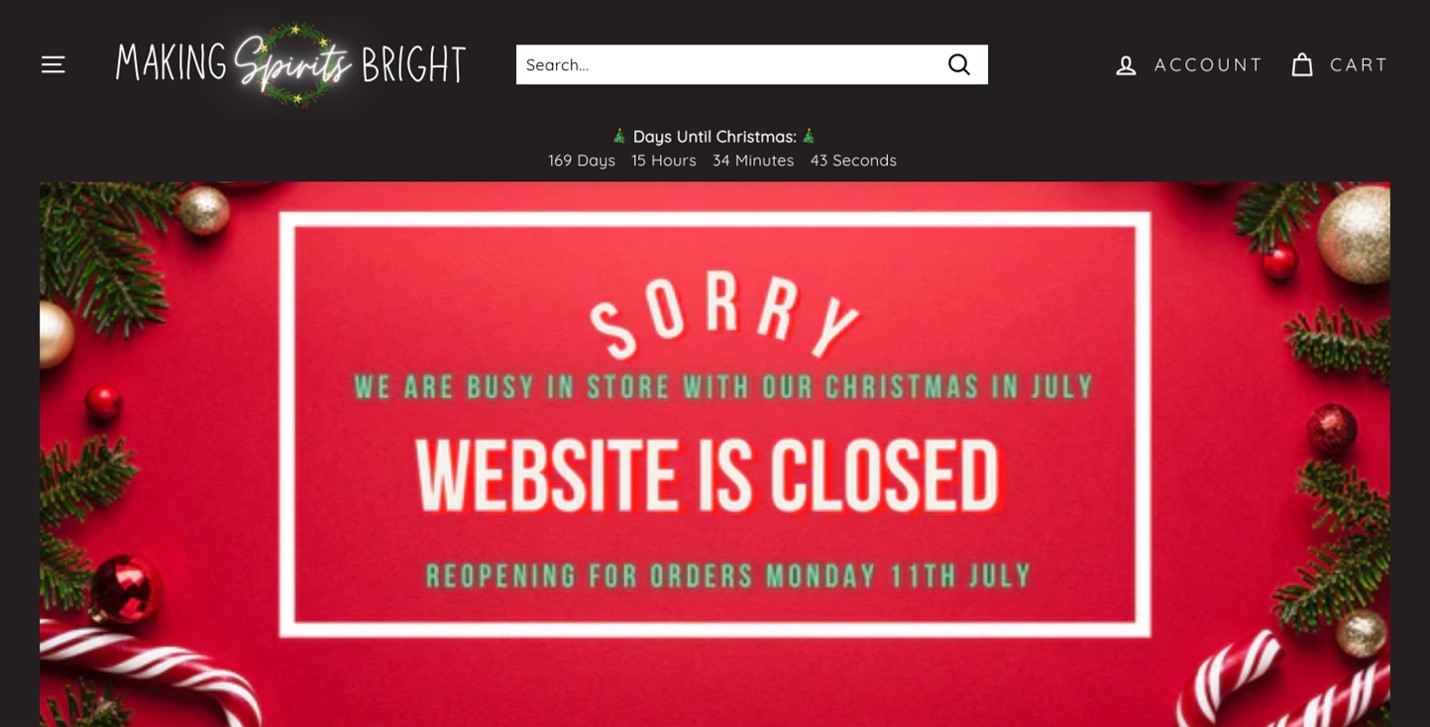Tips for small businesses to overcome seasonality

Before we get started, let me ask you this:
What’s the difference between spring rolls and summer rolls?
Seasoning.
Okay, okay, mum jokes aside, how are you and your business going?
I heard the Victorian Small Business Commissioner, Lynda McAlary-Smith, share recently, ‘You don’t decide to start a small business to have an easy life.’
Instead, I think you start a small business to have an inspired life, constantly learning, growing and – just like the seasons – changing.
Businesses often come and go simply because of failure to prepare for the seasonal cycles. For example, seasonal businesses are typically known for the cyclic fluctuations in demand for their products or services. The unique aspect of a seasonal business is that its market naturally fluctuates in a regular and predictable pattern over time, not just in response to random or unexpected changes in customer tastes or needs.
Owning a small business can be hugely rewarding but, for many, the challenge of maintaining a consistent revenue stream during the off-season can be stressful.
As someone who managed one of Victoria’s most seasonal businesses – a hot air balloon business that relies 100% on the daily weather forecast, not just seasons – I have a few things to share with you.
Because seasonality doesn’t have to be hard if managed appropriately, below, you will find a few quick and easy tips to help you manage your seasonal business and include seasonal content in your online strategy.
How to overcome seasonality challenges
1. Spread your cash flow over the year
There are many ways to stretch your cash flow to cover the quieter months. One of the simplest is to get creative with your invoicing. For example, if you are a service business, persuade your customers to pay upfront or if you have long-term contracts, negotiate to have clients pay in regular instalments.
On the expenses side, do whatever you can during the busy season to get you through the slow times. For example, negotiate with suppliers to extend payment terms to 60 or 90 days, ask for discounts, and pre-pay expenses such as rent, utilities, and maintenance so you don’t get hit with these costs when you can least afford them.
Finally, and most importantly, cut those expenses that aren’t necessary. For example, when was the last time you looked at your monthly subscriptions? Whether it’s a paid app you downloaded or a related web service, do you need this year-round or at all? It’s time to audit.
2. Diversify your business
A good way of beating seasonality is by diversifying your business.
For some, this might mean starting a new business or buying an existing business to complement your core offering. For others, a little innovation can uncover a new product line or a complimentary service that adds to your current offering.
A holiday resort, for example, might consider promoting business events and conferences during the off-season. Or a landscaper, who might typically have little work during the winter months, could also offer outdoor lighting services and solutions.
3. Generate sales with promotional events and gift vouchers
Everyone loves to bag a bargain. This doesn’t stop during your slow season.
Promotional events are a great way to stay in touch with your customers and bring revenue through the door, even during slow times.
You can try buy-one-get-one-free offers, selling old inventory, free memberships, or discounts. Plan your event well, build excitement and get those sales coming in.
Offering open-dated or monetary gift vouchers is another excellent way to distribute your product during the low season.
4. Find new customers
The market is changing, and so are the ways consumers find companies and buy products or services. What worked last year might not work this year. There is now a range of free and simple platforms that your small business can use for email marketing campaigns to stay in contact with your loyal customers.
Your existing customers are an excellent way to announce promotional events, exclusive discounts and new business lines.
Some digital technology can also go a long way to help reduce your business’s seasonality by expanding your reach and uncovering new customers in other locations. Whether through social media or online shopping platforms, branching into different markets – for example, Facebook Marketplace – will only boost your community and make a positive contribution to your revenue over the year.
5. Embrace your seasonality and plan ahead
Planning is your best bet for maintaining cash flow over the entire year. Take stock of your year-round expenses and staff commitments and know what sales are required to hit your target monthly.
Forecasting might not be the most exciting task, but it will help you to pinpoint exactly how much sales are necessary to get you through the year ahead.
So, no matter your small business, there are some simple and effective ways to reach out to customers, get more revenue over the entire year, and overcome seasonality.
Imagine a retail business in the Victorian country town of Bright, so busy in store they temporarily closed their website for any more orders in the middle of winter.

The inspiring story of Making Spirits Bright started as a giftware store, Country Heart and Home.
Owner Amanda and Brett Ralph embraced their booming seasonal Christmas trade by transitioning their gift store to a 100% premier Christmas store destination all year round, renaming their Christmas paradise to Making Spirits Bright. Don’t you love that!
When I first met Amanda and visited the store, I was so blown away by what this couple had achieved I grabbed all my gear and interviewed Amanda on a Facebook Live.
Read more about how you can prepare for seasonal events throughout the year in our companion article.

How to include seasonal content in your online strategy
High-quality content is the precursor to search engine optimisation (SEO) success. Another way to think of your SEO strategy is what I like to call your ‘findability’ strategy.
In other words, how are you aligning your website and broader social media strategy with seasonal content to help your potential customers find you according to what they, your potential customer, are searching for.
Regardless of how many backlinks you build, your website won’t rank on a Google search if it has little or no high-quality content. Rather than only creating evergreen content, you should diversify your website’s content with seasonal pieces. It may not generate the same steady and consistent traffic as evergreen content, but seasonal content can benefit your website’s SEO in other ways.
What is evergreen content?
Evergreen content is search-optimised content that is continually relevant and stays ‘fresh’ for readers over a long period.
It’s also called ‘evergreen’ because it never expires! You may think that all online content is sustainable; after all, a blog post doesn’t just disappear after you publish it. However, more than 90% of content on the web will disappear within 6 months due to lack of traffic or lack of importance as pieces of information become outdated or irrelevant.
But the idea of evergreen content isn’t just about longevity. It’s also about relevancy and staying fresh (or evergreen) with readers through updates and changes in the topics your brand covers or wants to cover.
What is seasonal content?
The opposite of evergreen content is seasonal content, defined by a cycling period of relevancy. However, it doesn’t remain relevant indefinitely after hitting the publish button or become permanently irrelevant.
Like the seasons of the year, it cycles. Seasonal content will become relevant for a short period, after which it will become irrelevant. At a later time, the cycle will repeat, with seasonal content becoming relevant once again.
News articles, for example, typically aren’t considered seasonal. Instead, they are usually relevant only for a short period after being published, after which they become and stay irrelevant. Fortunately, seasonal content is different because it regains its relevancy.
Think about your business. You may not sell chocolates or flowers, yet what love affair could you celebrate on Valentine’s Day to leverage the season of love and keep your website and business fresh and on top of your search engine game?
Identify seasonal topics
To create seasonal content, you must target topics with a cycling period of relevancy. Despite its name, seasonal content isn’t limited to topics involving the year’s 4 seasons.
While you can create seasonal content related to spring, summer, fall or winter, it supports other topics. For example, you can create seasonal content on any topic that cycles between periods of relevance and irrelevance.
Here’s an example I came across recently and loved the use of a seasonal theme like Valentine and a milestone anniversary to produce content that is not only seasonal but on-trend to Valentine’s with a great title, MCEC Celebrates a 25 Year Love Affair with Melbourne this Valentine’s Day.

You can see from this example that you don’t have to sell chocolates or flowers to create seasonal content to circulate during Valentine’s, a key period in February.
Identifying seasonal topics that are related to your website’s purpose work best. Some websites publish seasonal content about one or more seasons. For example, websites for heating, ventilation and cooling companies often publish articles related to residential heating and air conditioning during the summer.
Other websites publish seasonal content related to the holidays, such as eCommerce websites publishing gift-buying articles in November and December.
You can target any topic with a cycling period of relevancy as long as it’s related to your website’s purpose and the season.
Update regularly
While seasonal content has a cycling period of relevance, you should still go back and update it the following year. Seasonal content can become outdated if neglected. Depending on the specific topic, a piece of seasonal content may become factually inaccurate. Failure to fix it will result in dissatisfied users who may not return to your website.
Evaluate your website’s seasonal content at least once a year – preferably before it becomes relevant – to determine whether it needs updating. For example, if you discover an inaccurate statement, delete or replace it with a factually accurate one.
When evaluating your website’s seasonal content, check its links to ensure they still point to valid pages. Links in all forms of content can break. For example, when a webmaster deletes a page or moves it to a new location, the links pointing to that page will stop working. If a piece of seasonal content contains one or more broken links, it may receive low search rankings where it generates equally low organic traffic.
You can tell if a link is broken simply by clicking it. If a link leads you to a broken page with a 404 ‘not found’ error, it’s broken. You’ll have to change the link’s destination address to the correct URL to fix it. For seasonal content pieces with many external links, you can scan them for broken links using a dead link-checking tool like Dead Link Checker.
Creating high-quality seasonal content is an effective on-page SEO tactic. Defined by a cycling period of relevance, it will broaden your website’s digital content catalogue. With seasonal content, your website ranks for more keywords, receives more on-site engagement, earns more backlinks and generates massive amounts of traffic periodically. So get creative and talk about winter, spring, summer and autumn, and while you are there, what are you planning for Valentine’s Day, Melbourne Cup Day, Christmas and New Year? Start planning now!
In summary, the SEO benefits of updating your website and cycling seasonal content include:
- rank for new keywords that would otherwise not be possible
- more opportunities to earn backlinks from other websites
- increased on-site engagement
- encourages search engines to crawl your website
- huge amounts of traffic during periods of relevance
- ability to repurpose on social media
- less competition than that of evergreen content
Let’s recap and take action
If you are a seasonal business remember you play an integral role in your local communities health and economic development. Although it may be necessary for your business to take seasonal fluctuations into account, not every business is a seasonal one and you should be proud yours is. Furthermore, you can take the steps highlighted above to make your business better suited to work against seasonal fluctuations by improving your long-term business and marketing strategy by planning, preparing, creating and building year-round systems.
Read our article How to prepare for seasonal events throughout the year to help you get started.
While being in a seasonal business can affect your cash flow, it’s certainly not a reason to panic. By following these tips as you prepare for seasonality, you will be able to overcome this obstacle and continue to grow your business and win along the way.